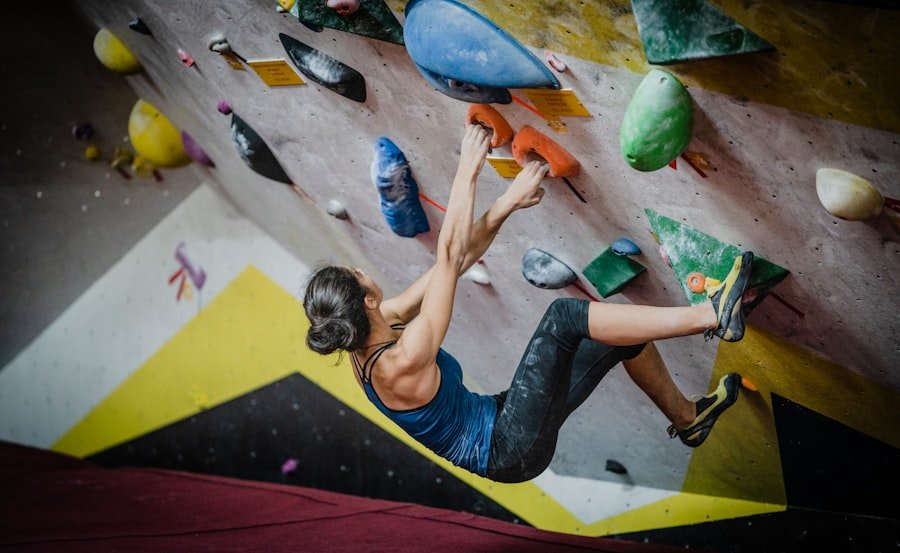
Maximize Your Hamstring and Glute Strength with Romanian Deadlifts
Romanian Deadlifts, also known as RDLs, are a popular exercise that primarily targets the hamstrings and glutes. This compound movement is performed by hinging at the hips and lowering a weight down towards the ground while maintaining a slight bend in the knees. Unlike traditional deadlifts, Romanian Deadlifts focus more on the eccentric or lowering phase of the movement, making it an effective exercise for building strength and muscle in the posterior chain.
The Romanian Deadlift has its origins in weightlifting and strength training. It was popularized by Romanian weightlifter Nicu Vlad, who won multiple Olympic medals in the 1980s and 1990s. Vlad’s unique technique of performing deadlifts with a slight knee bend and emphasis on the eccentric phase of the movement caught the attention of other athletes and coaches, leading to its widespread adoption as a staple exercise for developing hamstring and glute strength.
Key Takeaways
- Romanian Deadlifts are a great exercise for strengthening the hamstrings and glutes.
- Proper form and technique are crucial for avoiding injury and maximizing results.
- Equipment needed for Romanian Deadlifts includes a barbell and weights.
- Warm-up exercises such as hip bridges and leg swings can help prepare the body for Romanian Deadlifts.
- Beginner variations include using lighter weights and focusing on form, while advanced variations can include single-leg Romanian Deadlifts and deficit Romanian Deadlifts.
Benefits of Romanian Deadlifts for Hamstring and Glute Strength
Romanian Deadlifts are highly effective for targeting the hamstrings and glutes, two major muscle groups in the posterior chain. These muscles play a crucial role in overall fitness and athletic performance. Strong hamstrings and glutes not only improve lower body strength but also contribute to better posture, stability, and power generation.
Research studies have shown that Romanian Deadlifts are superior to other exercises when it comes to activating the hamstrings. A study published in the Journal of Strength and Conditioning Research found that Romanian Deadlifts elicited significantly higher hamstring muscle activation compared to other popular exercises like leg curls or stiff-legged deadlifts.
Additionally, strong glutes are essential for optimal hip function and stability. The gluteus maximus is the largest muscle in the body and plays a key role in hip extension, which is crucial for movements like running, jumping, and squatting. Romanian Deadlifts target the glutes by requiring a strong hip hinge and activation of the posterior chain.
Proper Form and Technique for Romanian Deadlifts
To perform Romanian Deadlifts with proper form and technique, follow these steps:
1. Stand with your feet hip-width apart and hold a barbell, dumbbells, or kettlebells in front of your thighs, palms facing your body.
2. Engage your core and maintain a neutral spine throughout the movement.
3. Hinge at the hips and push your glutes back while maintaining a slight bend in your knees.
4. Lower the weight down towards the ground by allowing your torso to lean forward while keeping your back straight.
5. Keep the weight close to your body as you lower it down, feeling a stretch in your hamstrings.
6. Once you reach the end of your range of motion or feel a stretch in your hamstrings, reverse the movement by driving through your heels and squeezing your glutes to return to the starting position.
It is important to maintain a neutral spine throughout the movement to avoid putting excessive stress on the lower back. Engaging the core muscles will help stabilize the spine and protect against injury. Common mistakes to avoid include rounding the back, lifting too heavy of a weight, or using momentum to complete the movement.
Equipment Needed for Romanian Deadlifts
| Equipment | Description |
|---|---|
| Barbell | A long metal bar with weights attached to each end |
| Weight Plates | Circular metal plates that are added to the barbell to increase weight |
| Weightlifting Belt | A thick belt worn around the waist to provide support and stability to the lower back |
| Chalk | A powdery substance that is applied to the hands to improve grip on the barbell |
| Deadlift Shoes | Specialized shoes with a flat sole and elevated heel to improve stability and balance during the lift |
Romanian Deadlifts can be performed with various types of equipment, including barbells, dumbbells, and kettlebells. Each type of equipment offers its own unique benefits and challenges.
Barbells are commonly used for Romanian Deadlifts due to their ability to handle heavier loads. They allow for progressive overload, which is essential for building strength and muscle. Dumbbells offer a greater range of motion and can be used to target each leg individually, helping to correct muscle imbalances. Kettlebells provide a different grip and can challenge stability and grip strength.
When choosing the right equipment for your fitness level and goals, consider factors such as your current strength, experience with the exercise, and any limitations or injuries you may have. It is always recommended to start with lighter weights and focus on proper form before progressing to heavier loads.
Warm-Up Exercises for Romanian Deadlifts
Before performing Romanian Deadlifts, it is important to warm up the muscles and prepare the body for the exercise. This helps to prevent injury and improve performance. Warm-up exercises that target the hamstrings and glutes can be beneficial in preparing these muscles for the demands of the Romanian Deadlift.
Some examples of warm-up exercises include leg swings, hip bridges, and bodyweight squats. Leg swings involve standing next to a wall or support and swinging one leg forward and backward in a controlled manner. This helps to increase blood flow to the hamstrings and improve mobility. Hip bridges are performed by lying on your back with your knees bent and feet flat on the ground. Lift your hips off the ground while squeezing your glutes, then lower back down. Bodyweight squats help to activate the glutes and prepare the lower body for the movement patterns involved in Romanian Deadlifts.
Beginner Romanian Deadlift Variations

For beginners or those new to Romanian Deadlifts, it is important to start with easier variations before progressing to more advanced ones. This allows for proper technique development and reduces the risk of injury.
One beginner variation is to use lighter weights or even just bodyweight. This allows for a focus on proper form and technique without overloading the muscles. Another variation is to perform the exercise with a slight bend in the knees instead of keeping them straight. This can help to reduce strain on the hamstrings and make it easier to maintain a neutral spine.
Starting with these beginner variations allows individuals to build a solid foundation of strength and technique before progressing to more challenging variations.
Intermediate Romanian Deadlift Variations
Once you have mastered the basic Romanian Deadlift, there are several intermediate variations that can be incorporated to continue making progress and challenging the muscles.
One intermediate variation is the single-leg Romanian Deadlift. This variation requires greater balance and stability, as well as increased activation of the glutes and hamstrings. Another variation is the deficit Romanian Deadlift, where the lifter stands on a raised platform or step, increasing the range of motion and further targeting the hamstrings.
These intermediate variations help to further develop strength, stability, and muscle activation in the posterior chain.
Advanced Romanian Deadlift Variations
For those looking to take their Romanian Deadlifts to the next level, there are advanced variations that can be incorporated into their training routine.
One advanced variation is the snatch grip Romanian Deadlift. This variation involves using a wider grip on the barbell, which increases the range of motion and places greater emphasis on the upper back and traps. Another advanced variation is the Romanian Deadlift with chains, where chains are added to the barbell to increase resistance throughout the movement.
These advanced variations provide a greater challenge and can help to prevent plateauing in strength and muscle development.
Common Mistakes to Avoid When Doing Romanian Deadlifts
When performing Romanian Deadlifts, it is important to avoid common mistakes that can lead to injury or hinder progress.
One common mistake is rounding the back during the movement. This places excessive stress on the spine and can lead to lower back pain or injury. To avoid this, focus on maintaining a neutral spine throughout the exercise and engage your core muscles to stabilize your spine.
Another mistake is lifting too heavy of a weight before mastering proper form and technique. This can compromise form and increase the risk of injury. It is important to start with lighter weights and gradually increase the load as strength and technique improve.
Using momentum to complete the movement is another mistake to avoid. This takes away from the effectiveness of the exercise and reduces the activation of the target muscles. Focus on performing the movement in a controlled manner, emphasizing the eccentric phase and feeling a stretch in the hamstrings.
Incorporating Romanian Deadlifts into Your Workout Routine
To incorporate Romanian Deadlifts into your workout routine, consider the following tips:
– Start by performing Romanian Deadlifts 1-2 times per week, allowing for adequate rest and recovery between sessions.
– Begin with lighter weights and focus on proper form and technique before increasing the load.
– Pair Romanian Deadlifts with other exercises that target different muscle groups, such as squats or lunges, to create a well-rounded lower body workout.
– Consider incorporating different variations of Romanian Deadlifts to continually challenge the muscles and prevent plateauing.
– As you progress, gradually increase the weight and intensity of your Romanian Deadlifts to continue making progress in strength and muscle development.
Incorporating Romanian Deadlifts into your workout routine can have numerous benefits for overall fitness and athletic performance. Not only do they target the hamstrings and glutes, but they also improve stability, posture, and power generation. By following proper form and technique, avoiding common mistakes, and gradually progressing in weight and difficulty, you can maximize the benefits of this effective exercise.
FAQs
What are Romanian deadlifts?
Romanian deadlifts are a type of exercise that targets the hamstrings, glutes, and lower back muscles. It involves bending forward at the hips while keeping the knees slightly bent and the back straight.
What are the benefits of Romanian deadlifts?
Romanian deadlifts can help improve hamstring and glute strength, increase hip mobility, and improve posture. They can also help reduce the risk of injury in the lower back and legs.
How do you perform Romanian deadlifts?
To perform Romanian deadlifts, stand with your feet shoulder-width apart and hold a barbell or dumbbells in front of your thighs. Keeping your back straight, bend forward at the hips and lower the weight towards the ground. Keep your knees slightly bent and your weight in your heels. Return to the starting position by squeezing your glutes and hamstrings.
How many sets and reps should I do?
The number of sets and reps you should do depends on your fitness level and goals. Generally, it is recommended to do 3-4 sets of 8-12 reps.
Are there any variations of Romanian deadlifts?
Yes, there are variations of Romanian deadlifts, such as single-leg Romanian deadlifts, stiff-legged deadlifts, and sumo deadlifts. These variations can target different muscles and provide a different challenge to your workout.

















